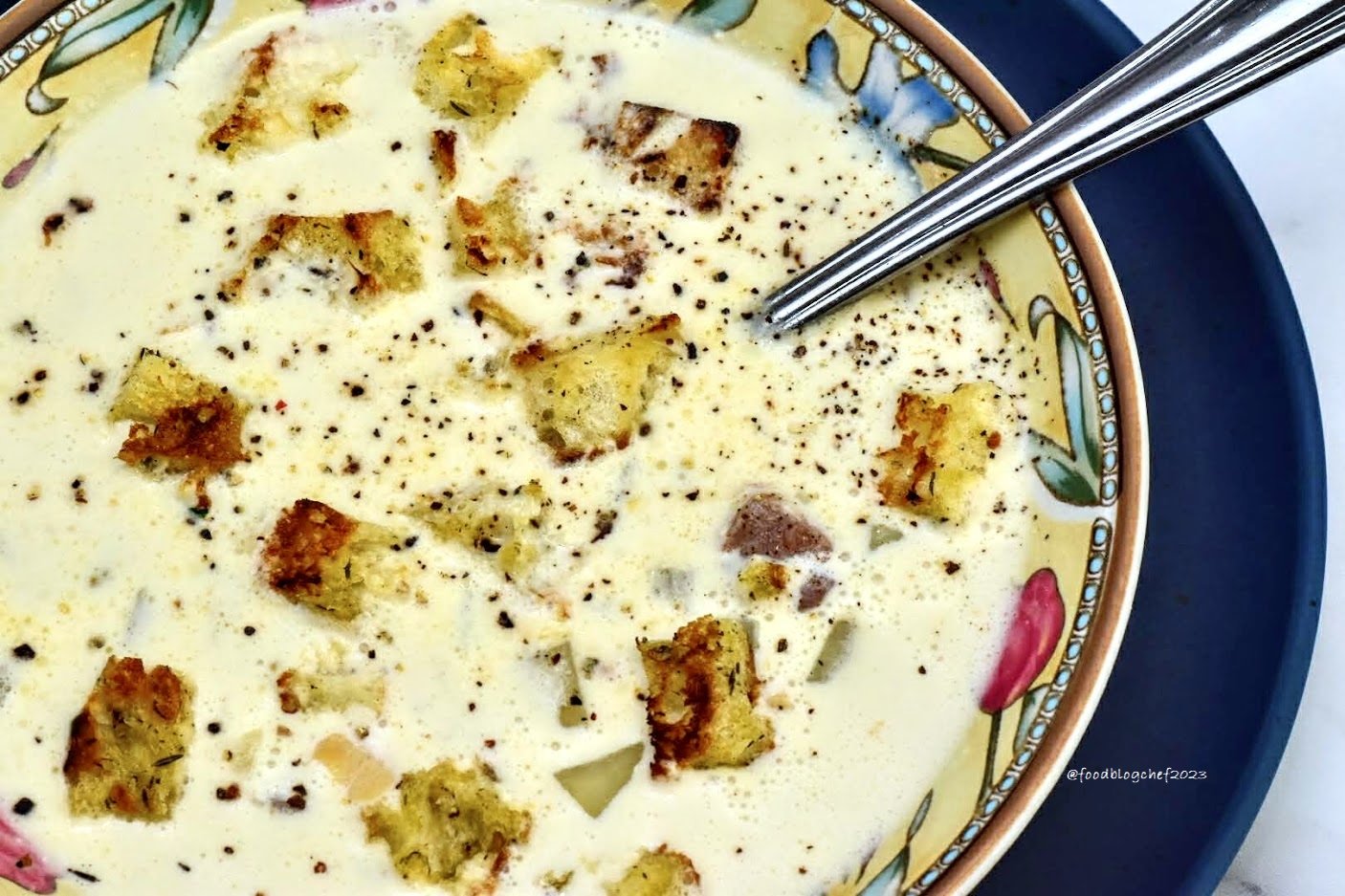New England Clam Chowder →
Food memories from my childhood are some of my fondest memories. As a native New Englander who spent the summers of his early years near the Rhode Island shore digging for clams, crabbing, and surf fishing, I am somewhat opinionated about seafood. In those days my grandfather and I could gather a bushel basket of littlenecks and cherrystone clams in a few hours. As we shucked them, we ate our fill of the succulent, briny raw littlenecks, then my grandmother would turn the harvest into clam cakes (fritters) and delicious New England Clam Chowder; sometimes the clear version, but my favorite was creamy, briny chowder full of chopped clams, diced potatoes, onion, celery, and salt pork or bacon. In honor of those childhood memories, recently I decided to research clam chowder recipes to develop my own ideal version of New England Clam Chowder: no tough, tasteless, over-cooked clams, or thick, pasty soup you-can-stand-a-spoon-up-in for me. My quest was for a delicate, creamy soup full of tender, barely cooked clams, accompanied by the usual potatoes, salt pork (or bacon), and aromatic vegetables. The following recipe meets my gastro-geek standards thanks to food consultant J. Kenji López-Alt who taught me about the magic of emulsifying the broth to create a delicate, creamy soup base without using flour and when to add the chopped clams so they don’t end up tough and tasteless. Apart from the broth, I tweaked my recipe departing from López-Alt’s to meet my own culinary aesthetic. The link to the original López-Alt recipe can be found at the end of this post. If you cook at home, you don’t have to settle for less-than-perfect clam chowder. Here’s my version. Enjoy!
New England Clam Chowder
Serves 4 as a main; 6 as a starter
Ingredients
¼ pound pancetta, salt pork, or slab bacon, cut into ¼ inch dice (Salt pork adds saltiness; bacon will add a smokey note to the chowder; pancetta is not traditional, but I like it in place of smokey bacon.)
2 tablespoons butter
1 medium onion, finely chopped (about 1 cup)
2 stalks of celery, finely chopped (about 1 cup)
1 cup bottled clam juice
2 ½ -3 pounds live cherrystone or littleneck clams (1-1 ½ cups chopped. See *Notes)
1 quart whole milk
1 pound+ of russet potatoes, peeled and cut into ¼ inch cubes (You want about 4 cups of diced potatoes)
2 bay leaves
Kosher salt and freshly ground black pepper (Optional: use a pinch of celery salt in place of the Kosher salt.)
1 cup heavy cream
Oyster crackers, saltines, or croutons for serving
Preparation
Sauté the diced pancetta or bacon in a heavy-bottomed stock pot or Dutch oven over medium heat, stirring occasionally until the fat has rendered, and the pork is brown and crisp, about 8 minutes. Add butter, onion, and celery. Continue to cook, stirring occasionally, until the onions are softened but not browned, about 4 minutes longer. Add the clam juice and stir to combine. (Note: if using chopped clams from a fish monger, in a separate pan, bring the bottled clam juice to a boil with a bay leaf, add the chopped clams and shut the heat off. Wait a minute and strain the clam juice into the saute reserving the clams for the last step.)
2. Add whole clams and increase heat to high. Cover and cook, opening the lid to stir occasionally, until clams begin to open, about 3 minutes. As clams open, remove them with tongs and transfer to a large bowl, keeping as many juices in the pot as possible and keeping the lid shut as much as possible. After 8 minutes, discard any clams that have not yet begun to open.
3. Reduce heat to medium-high and add the milk, potatoes, bay leaves, and a pinch of salt and a few turns of freshly ground black pepper to the pot. Bring to a boil, then reduce to a bare simmer, and cook, stirring occasionally, until the potatoes are tender and just starting to break down, about 8-10 minutes.
4. Meanwhile, remove the meat from the clamshells and chop it. Discard the empty shells (or sterilize them for a few minutes in boiling water and save them for your next batch of Baked Stuffed Clams). Transfer the chopped clams and as much juice as possible to a fine-mesh strainer set over a large bowl. Let the clams drain, then transfer the chopped clams to a separate bowl. Set both bowls aside.
5. Once the potatoes are tender, pour the entire mixture through a fine-mesh strainer into the bowl with the clam juice gently stirring the mixture to allow the liquids to pass through. Transfer the strained solids to the bowl with the chopped clams. You should end up with a white, semi-broken broth in the bowl underneath, and the chopped clams, potatoes, pancetta, and aromatics in a separate bowl.
6. Transfer the liquid to a blender and blend on medium-high speed until smooth and emulsified, about 2 minutes. Return the liquid and solids back to the Dutch oven. Add heavy cream and stir to combine. Reheat until well heated and simmering. (do not boil!) Taste and season with salt and pepper to suite your taste. Serve immediately with oyster crackers or Saltines.
Wine Pairing: Dry, white wines like Chablis, Vermentino, Albariño, Sauvignon Blanc
*Notes
For the best results, use live clams. If live clams are unavailable, skip steps 2 and 4. In step 6, add 1-1 ½ cups of chopped clams from your fishmonger, canned, or frozen clams to the chowder before heating through to serve.
Adapted from a recipe from: https://www.seriouseats.com/new-england-clam-chowder-recipe
J. Kenji López-Alt- food consultant to SeriousEats and NY Time food columnist
History:
https://www.thymemachinecuisine.com/single-post/2019/02/25/new-england-clam-chowder-the-history-of-the-name-origins-and-a-war
https://ictnews.org/archive/they-stole-our-soup-the-native-origins-of-new-england-clam-chowder














